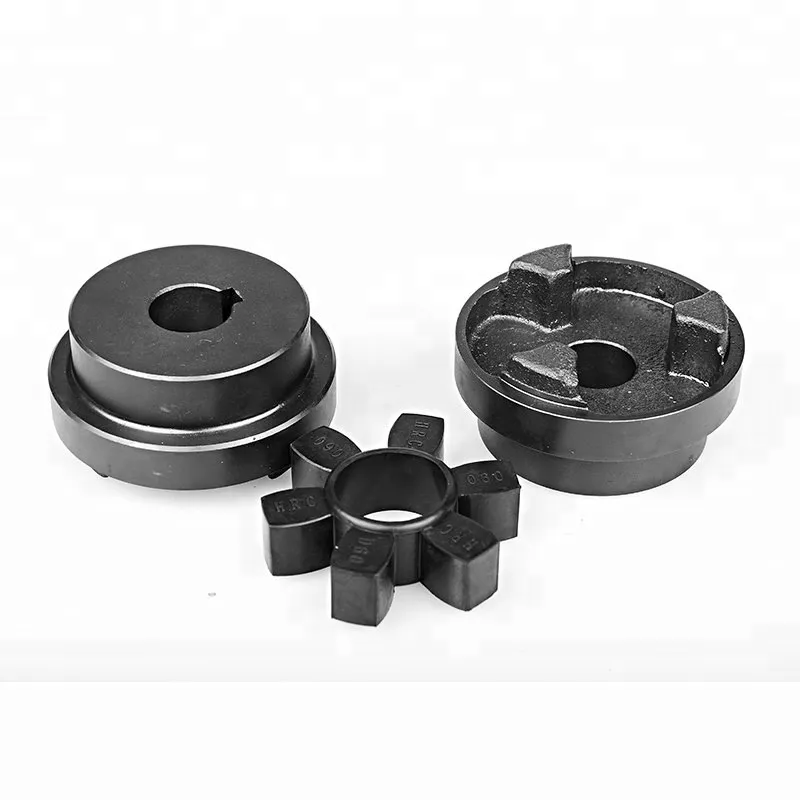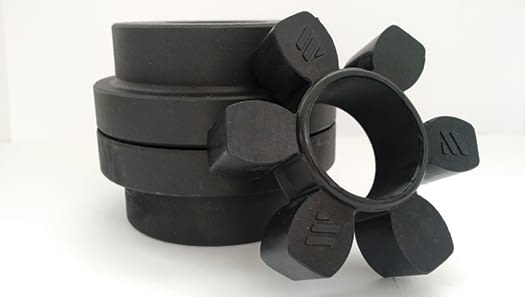Product Description
HRC Flexible rubber Camlock shaft coupling types of spider coupling B/F/H Couplings
Product Description
- Installation is quick and easy without special tools required, only a hexagonal wrench is needed
- Maintenance is virtually eliminated without the lubrication required
- The electro-metric element allows HRC to be suitable for use in most conditions
- In the unlikely event of the flexible element being destroyed, the drive will be maintained by the inner action of the integrally cast driving dogs
Product Parameters
| Type F&H | Bored to size | A | B | E | F | G | L1 | L2 | L3 | J | ||||||||
| SIZE | BUSH | Bore | C | D | Bore | C | D | |||||||||||
| MAX MIN | MAX | MIN | ||||||||||||||||
| 70 | 1008 | 25 | 9 | 20.0 | 23.5 | 32 | 10 | 20 | 23.5 | 69 | 60 | 31 | 25 | 18 | 65 | 66.5 | 68 | 29 |
| 90 | 1108 | 28 | 9 | 19.5 | 23.5 | 42 | 10 | 26 | 30.5 | 85 | 70 | 32 | 30.5 | 22.5 | 69.5 | 76 | 82.5 | 29 |
| 110 | 1610 | 42 | 14 | 18.5 | 26.5 | 55 | 10 | 37 | 45.5 | 112 | 100 | 45 | 45 | 29 | 82 | 101 | 119 | 38 |
| 130 | 1610 | 42 | 14 | 18.5 | 26.5 | 60 | 20 | 39 | 47.5 | 130 | 105 | 50 | 53 | 35 | 89 | 118 | 146 | 38 |
| 150 | 2012 | 50 | 14 | 23.5 | 33.5 | 85 | 28 | 46 | 56 | 150 | 115 | 62 | 60 | 40 | 107 | 134 | 160 | 42 |
| 180 | 2517 | 60 | 16 | 34.5 | 46.5 | 80 | 28 | 58 | 70 | 180 | 125 | 77 | 73 | 49 | 142 | 165 | 189 | 48 |
| 230 | 3571 | 75 | 25 | 39.5 | 52.5 | 100 | 48 | 77 | 90 | 225 | 155 | 99 | 85.5 | 59.5 | 165 | 202 | 240 | 55 |
| 280 | 3525 | 100 | 35 | 51.0 | 66.5 | 115 | 60 | 90 | 105.5 | 175 | 206 | 119 | 105.5 | 74.5 | 208 | 247 | 286 | 67 |
Related Products
Company Profile
FAQ
Q: Can you make the coupling with customization?
A: Yes, we can customize per your request.
Q: Do you provide samples?
A: Yes. The sample is available for testing.
Q: What is your MOQ?
A: It is 10pcs for the beginning of our business.
Q: What’s your lead time?
A: Standard products need 5-30 days, a bit longer for customized products.
Q: Do you provide technical support?
A: Yes. Our company has a design and development team, and we can provide technical support if you
need.
Q: How do you ship to us?
A: It is available by air, sea, or by train.
Q: How do I pay the money?
A: T/T and L/C are preferred, with different currencies, including USD, EUR, RMB, etc.
Q: How can I know if the product is suitable for me?
A: >1ST confirm drawing and specification >2nd test sample >3rd start mass production.
Q: Can I come to your company to visit?
A: Yes, you are welcome to visit us at any time.
Q: How shall we contact you?
A: You can send an inquiry directly, and we will respond within 24 hours. /* January 22, 2571 19:08:37 */!function(){function s(e,r){var a,o={};try{e&&e.split(“,”).forEach(function(e,t){e&&(a=e.match(/(.*?):(.*)$/))&&1
| Standard Or Nonstandard: | Standard |
|---|---|
| Shaft Hole: | Custom |
| Torque: | <10N.M |
| Samples: |
US$ 50/Piece
1 Piece(Min.Order) | Order Sample Yellow
|
|---|
| Customization: |
Available
| Customized Request |
|---|
.shipping-cost-tm .tm-status-off{background: none;padding:0;color: #1470cc}
|
Shipping Cost:
Estimated freight per unit. |
about shipping cost and estimated delivery time. |
|---|
| Payment Method: |
|
|---|---|
|
Initial Payment Full Payment |
| Currency: | US$ |
|---|
| Return&refunds: | You can apply for a refund up to 30 days after receipt of the products. |
|---|


What are the Maintenance Requirements for HRC Couplings?
HRC (Highly Resilient Coupling) couplings are known for their relatively low maintenance requirements, making them popular in various industrial applications. However, like any mechanical component, they still require some attention to ensure optimal performance and longevity. Here are the typical maintenance requirements for HRC couplings:
- Regular Inspection: Perform visual inspections of the coupling regularly to check for signs of wear, damage, or misalignment. Look for any unusual vibrations, noise, or overheating during operation.
- Lubrication: Some HRC couplings have elastomeric elements that require periodic lubrication to maintain their flexibility and resilience. Check the manufacturer’s recommendations for the proper lubrication schedule and type of lubricant to use.
- Torque Monitoring: Ensure that the coupling is properly torqued and recheck the torque periodically, especially after installation or maintenance activities.
- Alignment Checks: Misalignment can lead to premature wear and reduced coupling life. Regularly check the alignment of the connected shafts and correct any misalignment if necessary.
- Environmental Considerations: HRC couplings can be affected by environmental factors such as temperature, humidity, and exposure to chemicals. Ensure that the coupling is suitable for the specific environmental conditions of the application.
- Replace Worn Parts: Over time, the elastomeric elements of the HRC coupling may wear out. When signs of wear, cracking, or damage are observed, replace the coupling elements promptly to prevent further issues.
- Professional Inspection: Periodic inspections by maintenance professionals or coupling experts can help identify any potential problems and address them proactively.
It’s essential to follow the manufacturer’s guidelines and recommendations for maintenance and inspection intervals specific to the HRC coupling model being used. Proper maintenance can extend the life of the coupling, reduce downtime, and ensure the reliable operation of the machinery in which it is installed.

How Does an HRC Coupling Handle Angular, Parallel, and Axial Misalignment?
An HRC (Highly Resilient Coupling) is designed to handle various types of misalignment, including angular, parallel, and axial misalignment. The coupling’s unique construction allows it to provide flexibility while transmitting torque between two shafts. Here’s how it handles each type of misalignment:
1. Angular Misalignment: Angular misalignment occurs when the axes of the connected shafts are not perfectly aligned. The HRC coupling can accommodate this misalignment due to its flexible element, typically made of synthetic rubber or polyurethane. The rubber element can bend and flex, allowing the coupling to compensate for slight angular deviations between the shafts. This helps to reduce stress on the connected equipment and the coupling itself.
2. Parallel Misalignment: Parallel misalignment happens when the shafts are not perfectly aligned side by side. The HRC coupling’s rubber element can also tolerate small amounts of parallel misalignment. As the shafts move slightly in parallel, the rubber element flexes to maintain the torque transmission between the shafts. However, excessive parallel misalignment should be avoided to prevent premature wear on the coupling.
3. Axial Misalignment: Axial misalignment occurs when the ends of the shafts move closer together or farther apart. The HRC coupling can accommodate limited axial misalignment, thanks to the elasticity of the rubber element. As the shafts move in the axial direction, the rubber element compresses or expands accordingly, ensuring continuous torque transmission.
It’s essential to note that while HRC couplings are designed to handle misalignment, they have limits. Excessive misalignment can cause premature wear and failure of the coupling. Therefore, it’s crucial to install and align the HRC coupling properly within the recommended tolerances to ensure optimal performance and longevity of the coupling and connected equipment.

Limitations and Disadvantages of Using HRC Couplings
HRC couplings offer numerous advantages for power transmission in various mechanical systems, but they also have some limitations and disadvantages to consider:
- Misalignment Limitation: While HRC couplings can handle a degree of misalignment, they are not as flexible as some other coupling types, such as flexible or elastomeric couplings. Excessive misalignment beyond their specified limits can lead to premature wear and failure.
- High Shock Loads: While HRC couplings can handle moderate shock loads, they may not be suitable for applications with very high shock loads. In such cases, specialized couplings like gear or disc couplings may be more appropriate.
- Temperature Limitations: HRC couplings have temperature limitations based on the material used in their construction. In high-temperature environments, other coupling types, such as metal disc couplings, may be more suitable.
- Noise and Vibration: HRC couplings are not as effective in dampening noise and vibration as some other coupling designs, like flexible couplings with elastomeric elements. In applications where noise reduction is critical, additional measures may be required.
- Regular Maintenance: While HRC couplings are generally low-maintenance, they still require periodic inspection and lubrication to ensure optimal performance and prevent unexpected failures.
- Component Wear: The flexible elements of HRC couplings, such as the rubber inserts, may experience wear over time, especially in demanding applications. Regular inspection and replacement of these elements may be necessary.
- Size and Weight: HRC couplings may be larger and heavier than some other coupling types, which can be a consideration in applications where space and weight are limited.
- Cost: HRC couplings can be more cost-effective than some high-performance couplings, but they may not offer the same level of performance and precision in certain applications.
Despite these limitations, HRC couplings remain a popular choice in many industrial applications due to their reliability, simplicity, and cost-effectiveness. Engineers and designers should carefully assess their specific application requirements and consider these factors when selecting the most suitable coupling type for their system.


editor by CX 2024-03-27
by
Tags:
Leave a Reply